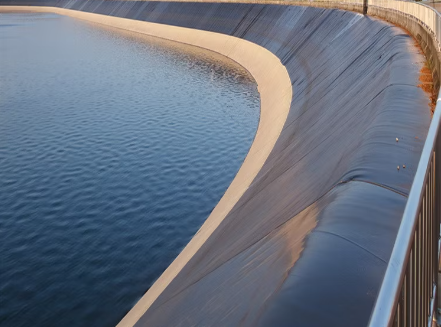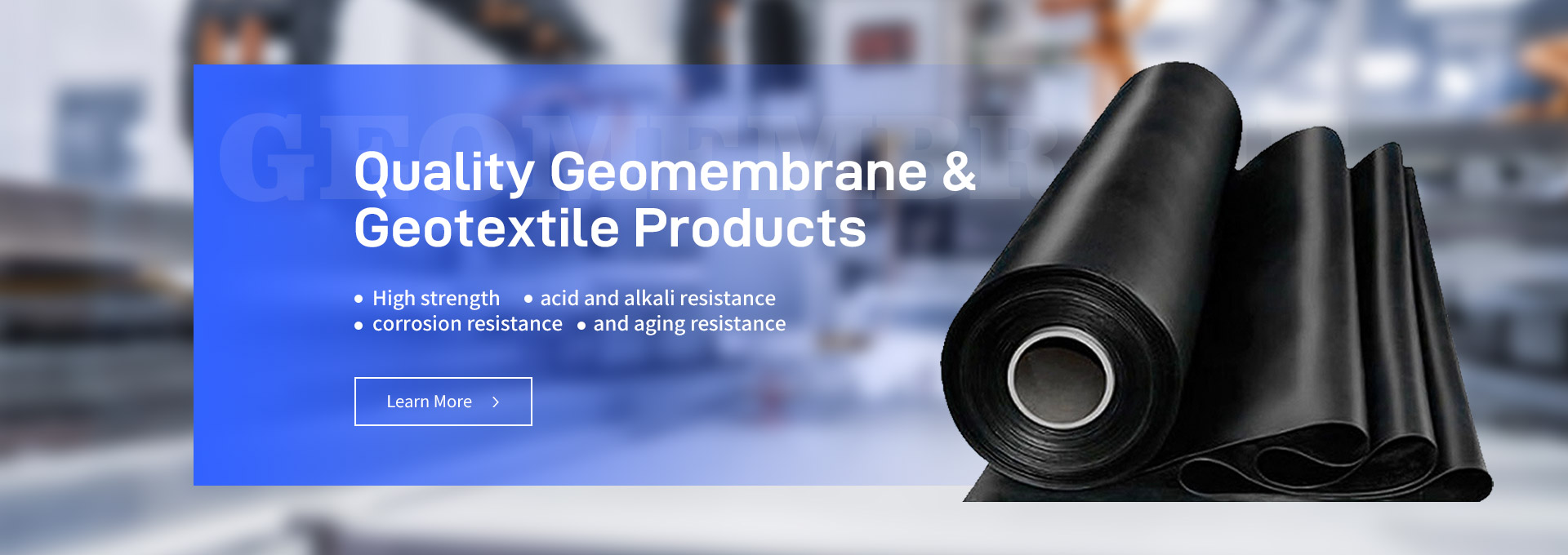In recent years, composite geomembranes have gained significant popularity in water conservancy projects due to their durability, flexibility, and excellent water resistance. A composite geomembrane is a versatile material widely used in various applications, including dam lining, water storage, and environmental protection. This engineered product typically consists of a geomembrane layer combined with a nonwoven geotextile, offering enhanced strength, flexibility, and long-lasting performance.

What is a Composite Geomembrane?
A composite geomembrane is a synthetic material used to provide waterproofing and separation solutions in engineering projects. It is made by bonding a geomembrane (usually made of materials like HDPE, LDPE, or PVC) with a geotextile layer (typically nonwoven fabric). This combination provides both the impermeability of the geomembrane and the filtration and drainage properties of the geotextile. The result is a highly effective barrier that prevents water from leaking out of reservoirs, ponds, and other water storage systems, while also offering resistance to punctures, abrasions, and chemical damage.
In water conservancy projects, composite geomembranes are used in various forms—lining water storage facilities, controlling seepage in dams, and ensuring the protection of valuable water resources. Their effectiveness in maintaining water quality and preventing contamination has made them an indispensable part of modern water management systems.
Applications of Composite Geomembranes in Water Conservancy Projects
1. Water Storage and Reservoirs
One of the primary applications of composite geomembranes is in the lining of water storage reservoirs. These geomembranes act as a barrier to prevent water from seeping into the ground and ensure that the stored water remains intact. In areas where natural clay or soil is not impermeable enough to contain water, composite geomembranes offer a reliable and cost-effective solution. Their use in water reservoirs ensures that water is efficiently stored and can be used for agricultural irrigation, industrial purposes, or even as a source of potable water in some cases.
The water storage pond geomembrane is particularly important in applications where large volumes of water need to be stored for long periods. These geomembranes can withstand high water pressure, and their ability to resist chemical and UV degradation makes them ideal for use in outdoor environments. With proper installation, a water storage pond geomembrane can ensure the safe storage of water while minimizing the risk of leaks and contamination.
2. Dam and Levee Linings
Composite geomembranes are also extensively used in the construction and rehabilitation of dams and levees. These water retention structures are designed to control and manage the flow of water, and geomembranes provide an added layer of security by preventing seepage. In the case of dams, preventing seepage is critical to maintaining the integrity and stability of the structure, ensuring that water does not escape from the reservoir, and avoiding erosion and damage to surrounding ecosystems.
The use of composite geomembranes in dam linings significantly reduces the maintenance requirements of these structures and improves their lifespan. By providing a strong, impermeable layer, geomembranes help to control the flow of water and prevent costly repairs and potential failures caused by water leakage.
3. Canals and Irrigation Systems
In regions where water is scarce and efficient irrigation is essential for agriculture, composite geomembranes play a crucial role in preventing water loss from canals and irrigation systems. Lining the canals with composite geomembranes helps to reduce evaporation and seepage, ensuring that water is delivered directly to the crops without unnecessary losses.
By using composite geomembranes in irrigation canals, farmers can significantly improve water conservation, reduce the need for excessive irrigation, and optimize the use of available water resources. This is especially important in arid regions where water conservation is vital for sustainable agricultural practices.
Benefits of Using Composite Geomembranes in Water Conservancy Projects
1. Cost-Effectiveness
One of the primary reasons for the increasing use of composite geomembranes in water conservancy projects is their cost-effectiveness. The installation of geomembranes can often be less expensive than other traditional methods of water containment, such as concrete or clay liners. Additionally, the long lifespan and low maintenance requirements of composite geomembranes further contribute to their cost efficiency, making them a preferred option for large-scale water projects.
2. Durability and Longevity
Composite geomembranes are designed to withstand harsh environmental conditions, including extreme temperatures, UV radiation, and chemical exposure. Their high tensile strength and resistance to punctures and tears ensure that they maintain their integrity over time. This durability makes them ideal for use in areas where water storage is critical, such as in water storage ponds and dams, as well as in regions with harsh weather conditions.
3. Environmental Protection
In water conservancy projects, the environmental protection offered by composite geomembranes is a key benefit. By preventing water leakage and contamination, these geomembranes help to protect groundwater and surrounding ecosystems from harmful pollutants. The use of geomembranes ensures that water resources are utilized efficiently while minimizing the risk of environmental damage.
Factors to Consider When Choosing a Composite Geomembrane
1. Material Type
There are several types of composite geomembranes available, including those made from HDPE, PVC, and other materials. The choice of material depends on factors such as the type of water conservancy project, the environmental conditions, and the required durability.
2. Geomembrane Price
When considering the use of composite geomembranes, it is important to factor in the geomembrane price. While geomembranes can be more expensive upfront compared to other methods of water containment, their long-term benefits, such as reduced maintenance costs and improved durability, make them a cost-effective solution in the long run.
3. Thickness and Flexibility
The thickness of the geomembrane is another important consideration. A thicker geomembrane may offer greater durability and resistance to punctures, but it may also be more expensive. Flexibility is also crucial for ensuring that the geomembrane can adapt to the contours of the terrain, especially in complex projects like water storage ponds.
Conclusion
Composite geomembranes have revolutionized water conservancy projects by providing a durable, cost-effective, and environmentally friendly solution for water containment and management. From water storage ponds to dams and irrigation systems, the application of composite geomembranes ensures that water resources are used efficiently and protected from contamination. Their strength, longevity, and ease of installation make them an invaluable tool in modern water management practices. As the demand for sustainable water conservation continues to grow, composite geomembranes will remain an essential part of water conservancy projects worldwide.

